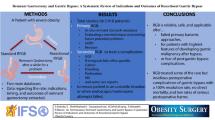ABSTRACT
Background
Controversies exist about the optimal palliative management for patients with metastatic antropyloric adenocarcinoma. The aim of this study was to analyse the clinical outcome for patients with gastric outlet obstruction syndrome and metastatic antropyloric adenocarcinoma, who underwent endoscopic stenting or open gastrojejunostomy, in a prospective not randomised study.
Material
The clinical course and costs for 70 patients who had endoscopic stenting and for 30 patients who had in the same period a gastrojejunostomy for gastric outlet obstruction syndrome due to metastatic adenocarcinoma of the antropyloric region were prospectively analysed.
Results
Hospital stay and time to resume oral feeding was shorter in patients who had endoscopic stenting (p < 0.05). Overall costs for endoscopic stenting were lower than those for gastrojejunostomy (11,000 versus 21,000 euros). Comparing patients who survived more than 6 months, costs between endoscopic stenting and gastrojejunostomy were similar (21,000 versus 22,000 euros).
Conclusions
Endoscopic placement of metallic stents offers an effective therapy in patients with advanced primay adenocarcinoma of the antropyloric region and poor general conditions. In patients with longer life expectancy, surgical gastroenterostomy has still a major role. In contrast to previous reports, costs for endoscopic stenting are similar to those of gastrojejunostomy in patients with longer life expectancy. Laparoscopic gastrojejunostomy has the theoretical advantage to reduce these costs with a less invasive procedure. Results for endoscopic stenting have improved significantly in recent years.

Similar content being viewed by others
References
Hunday SA, Philips JL, Menck HR “The National Cancer Data Base Report on poor survival of US gastric carcinoma patients treated with gastrectomy. Fifth edition American Joint Committee on cancer staging, proximal disease and different disease” Cancer 2000; 88:921–932
Fiori E, Lamazza A, Sterpetti AV: “Endoscopic stenting and gastrojejunostomy for gastric outlet obstruction due to unresectable antropyloric adenocarcinoma: final results of a prospective study and review of the literature. Am J Surg 2013;206: 210–217
Adler DG, Baron TH “Endoscopic palliation of malignant gastric outlet obstruction using self-expanding metal stents: experience in 36 patients”. Am J Gastroenterol 2002; 97:72–78
Lee JM, Han YM, Kim CS et al. “Fluoroscopic-guided covered metallic stent placement for gastric outlet obstruction and post-operative gastroenterostomy anastomotic stricture”. Clin Radiol 2001; 56: 560–567
Havemann MC, Adamsen S, Wøjdemann M.” Malignant gastric outlet obstruction managed by endoscopic stenting: a prospective single-centre study”. Scand J Gastroenterol. 2009;44:248–51.
Jeurnink SM, van Eijck CH, Steyerberg EW et al.: “Stent versus gastrojejunostomy for the palliation of gastric outlet obstruction: a systematic review” BMC Gastroenterology 2007 7:18
Ly J, O’Grady G, Mittal A et al.:” A systematic review of the methods to palliate malignant gastric obstruction” Surg Endosc 2010; 24: 290–297
Dormann A, Meisner S, Verin N et al. “Self-expanding metal stents for gastroduodenal malignancies: systematic review of their clinical effectiveness”.Endoscopy. 2004;36(6):543–50.
Kim CG, Choi IJ, Lee JY et al. “Covered versus uncovered self-expandable metallic stents for palliation of malignant pyloric obstruction in gastric cancer patients: a randomized, prospective study”. Gastrointest Endosc. 2010;72:25–32.
Kim CG, Park SR, Choi IJ et al. “Effect of chemotherapy on the outcome of self-expandable metallic stents in gastric cancer patients with malignant outlet obstruction. Endoscopy. 2012;44:807–12.
Schwarz RE: “Current status of management of malignant disease: Current management of gastric cancer” J Gastrointest Surg 2015; 19: 782–788
Author information
Authors and Affiliations
Corresponding author
Ethics declarations
Funding
No fund was received for this paper.
Conflicts of Interest
None of the authors has conflicts of interest to declare.
Rights and permissions
About this article
Cite this article
Fiori, E., Sterpetti, A.V., De Cesare, A. et al. Factors Leading to Improved Results for Endoscopic Stenting for Metastatic Antropyloric Adenocarcinoma. A Comparison with Gastrojejunostomy. J Gastrointest Surg 20, 1802–1806 (2016). https://doi.org/10.1007/s11605-016-3236-6
Received:
Accepted:
Published:
Issue Date:
DOI: https://doi.org/10.1007/s11605-016-3236-6




